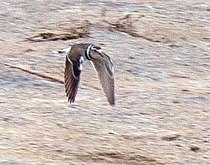Three-banded plover
| Three-banded plover | |
|---|---|

| |
| Chobe National Park,Botswana | |
| Scientific classification | |
| Domain: | Eukaryota |
| Kingdom: | Animalia |
| Phylum: | Chordata |
| Class: | Aves |
| Order: | Charadriiformes |
| Family: | Charadriidae |
| Genus: | Charadrius |
| Species: | C. tricollaris
|
| Binomial name | |
| Charadrius tricollaris Vieillot,1818
| |
Thethree-banded plover,orthree-banded sandplover(Charadrius tricollaris), is a smallwader.Thisploveris resident and generally sedentary in much ofEast Africa,southern AfricaandMadagascar.It occurs mainly on inland rivers, pools, lakes and pans, frequenting their exposed shores. This species is often seen as single individuals, but it will form small flocks. It hunts by sight for insects, worms and otherinvertebrates.Three-banded plovers have a sharp whistledweeet-weetcall. Its larger and darker-plumagedsister species,Forbes's plover,replaces it inWest Africaand in the moist tropics. The two species have largelyallopatricbreeding ranges. Both species present a distinctively elongated profile, due to their proportionally long tail and wings.
Description
[edit]The adult three-banded plover is 18 cm in length. It has long wings and a very long tail, and therefore looks different from most other small plovers in flight, the exception being the closely related Forbes's plover.
The adult three-banded plover has medium brown upperparts, and the underparts are white except for the two black breast bands, separated by a white band, which give this species its common and scientific names. The head is strikingly patterned, with a black crown, whitesuperciliaextending from the white forehead to meet on the back of the neck, and a grey face becoming brown on the neck. Theorbital ringisorange-red,and the base of the otherwise black bill is rosy red in colour.
The Malagasy subspeciesC. t. bifrontatushas a grey band between the bill and the white forehead, and the sides of the head are grey. A genetic study reported genetic differentiation between Madagascar and the mainland population.[2]The sexes are similar with respect to plumage and size.[3]Juveniles of the nominate and Malagasy subspecies also resemble the adults, although the forehead is brownish for a short time, and the wing coverts show buff fringes.[4]This species is distinguished from the larger and darker Forbes's plover in that the latter has a brown forehead and lacks a white wingbar.
Breeding
[edit]Its nest is a bare scrape on shingle. Egg laying occurs from March to June in the tropics,[4]but mainly (over 70%) from July to October (i.e. late winter to early spring) in southern Africa.[5][6]
References
[edit]- ^BirdLife International (2016)."Charadrius tricollaris".IUCN Red List of Threatened Species.2016:e.T22727471A94950399.doi:10.2305/IUCN.UK.2016-3.RLTS.T22727471A94950399.en.Retrieved11 November2021.
- ^Remedios, Natalie Dos; Küpper, Clemens; Székely, Tamás; Zefania, Sama; Burns, Fiona; Bolton, Mark; Lee, Patricia L. M. (2020)."Genetic structure among Charadrius plovers on the African mainland and islands of Madagascar and St Helena".Ibis.162(1): 104–118.doi:10.1111/ibi.12694.ISSN1474-919X.
- ^Zefania, Sama; Emilienne, Razafimahatratra; Faria, Patrícia J; Bruford, Michael W; Long, Peter R; Székely, Tamás (2010-11-11)."Cryptic sexual size dimorphism in Malagasy plovers Charadrius spp".Ostrich.81(3): 173–178.doi:10.2989/00306525.2010.519909.ISSN0030-6525.
- ^abHayman, Peter; Marchant, John; Prater, Tony (1986).Shorebirds – An identification guide: 96 Three-banded ploverCharadrius tricollaris.Boston: Houghton Mifflin Company. p. 116-117, 290-291.ISBN0-395-37903-2.
- ^Tarboton, Warwick (2001).A Guide to the Nests and Eggs of Southern African Birds.Cape Town: Struik. p. 141.ISBN1-86872-616-9.
- ^Tarboton, W. R.; Kemp, M. I.; Kemp, A. C. (1987).Birds of the Transvaal.Pretoria: Transvaal Museum. p. 90.ISBN0-620-10006-0.
- Ian Sinclair, Phil Hockey and Warwick Tarboton,SASOL Birds of Southern Africa(Struik 2002)ISBN1-86872-721-1
- Hayman, Marchant and PraterShorebirdsISBN0-395-60237-8
External links
[edit]- Three-banded plover -Species text in The Atlas of Southern African Birds.




